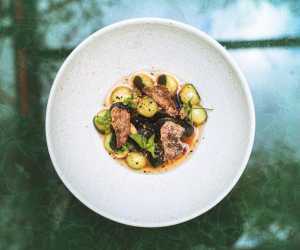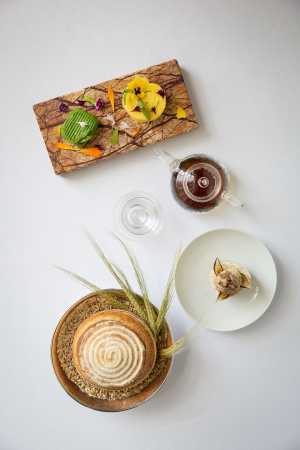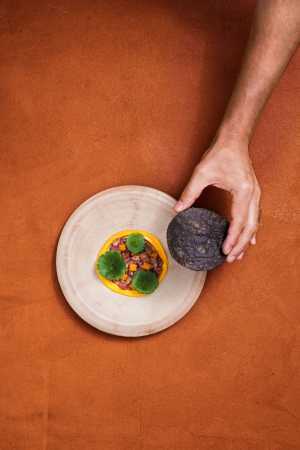"It's not my favourite cocktail," I respond hesitantly, "because I really, really don't like almond essence."
My host Isabel Davies, co-founder of Native, looks triumphant. "That's the thing! It doesn't taste like almond essence. Because it's something else entirely. It's meadowsweet."
She jumps up from the table and, moments later, presents me with her take on an 'amaretto' sour: a sour-style cocktail based on foraged meadowsweet flowers, the petals of which tastes like almonds. It's light, smooth, and tastes more like actual almonds than amaretto ever has. "Amazing, isn't it," beams Davies. "Have you tried pineapple weed?"
Within half an hour I'm triple parked, the pineapple weed – a weed that, you guessed it, tastes like pineapple – having appeared in the form of a delectably light piña colada, which is swiftly followed by a seaweed martini.
Native isn't just a bar (in fact it's first and foremost a restaurant) but the bar is Davies' domain, while her co-founder Ivan Tisdall-Downes takes care of the kitchen.
Pineapple weed appears in the form of a delectably light piña colada
Bar the wild garlic pesto I (along with everyone else) made during lockdown, I am new to the world of wild food, and Davies is all too delighted to introduce me to it.
"Have you ever had ants before?!" she exclaims, with the wild, giddy excitement you'd expect from someone who has suddenly realised you might not have heard of Beyonce. "Let me get you some" – and with that, she jumps off her chair and bounds behind the bar for the fourth time that afternoon.
For a second, I fear the ants may also arrive in drink form (even I draw the limit at quadruple parking on a Thursday afternoon), but they really are just ants: black, spindly and upon tasting, remarkably reminiscent of lemon zest.
"That pop of formic acid – it's so citrussy, it really excites me," says Davis. "You can have the tastiest, creamiest dish, but if you want something to cut through that and add a different level of flavour, it's difficult. That's where the ants come in."
Of course, this difficulty is entirely of their own making.
They could use lemons, or limes or any number of imported citrus fruit – most restaurants do, of course – but Native is one of a growing number of restaurants and bars eschewing commonly imported ingredients in favour of locally sourced alternatives: sea buckthorn instead of orange; melilot flowers instead of vanilla; hogweed seeds instead of coriander.
Where possible, local means their doorstep, or as good as: herbs, flowers, weeds, funghi and grasses plucked from meadows, hedgerows and forest.
Even if you didn't personally engage with the foraging phase of lockdown, you'll doubtless have woken up to just how much free food surrounds us.
"Walking home from work, seeing some pineapple weed and thinking, I'll make something with that doesn't make me a wild child. It's not crazy to pick a blackberry," says Davies – though it is important, she reminds me, to leave some for next year and for the birds.
"I grew up in South East London eating Wagon Wheels and fried chicken, and now I see the world as an edible landscape," says Tisdall-Downes excitedly.
I grew up in London eating fried chicken; now I see the world as an edible landscape
I can't say I've come that far, but I am more alive to the fragrant, flavoursome wild fennel, elderflower and sorrel that line London's backstreets than I was before.
What I hadn't considered (until sampling Native's meadowsweet sour) is how these ingredients can be used not just in their own right, but instead of foods we can't grow in the UK: thereby reducing our carbon footprint, supporting British producers and foragers, and creating a dish that is truly local.
Inevitably in the current climate such claims can smack of jingoism, so before I proceed, a caveat: none of these chefs are denying the influence of other countries – of empire – on British food culture.
Nor are they downplaying the role we've had in globalising supply chains – rendering, for example, Kenyan green bean farmers dependent on exporting their crop to us 365 days a year.
For the most part, they are just trying to create a delicious meal that aligns with their values and offers a distinct sense of place: Kent and London, in the case of Native; the Midlands in the case of Brad Carter of Carters of Moseley; Yorkshire in the case of Shaun Rankin of Grantley Hall.
Chef Drew Nehmann’s pop-up in Camberwell drew rave reviews. His seasonal food is made using foraged produce
If you don't want to know those values, they won't force-feed them to you: they'll just feed you.
"The only reason you're hearing me talk about it right now is because you're asking me," laughs Drew Snaith, a chef formerly of Le Manoir aux Quat'Saisons, whose pop-up restaurant Nehmann emerged to clamouring success in Camberwell in July and August, and is searching for a permanent site.
"If guests want to know, then great: I can talk their ears off, but my focus is on deliciousness first and foremost. Otherwise, what's the point?"
Besides, the proof of the principles underpinning these dishes are mostly evident in the eating: dishes like fermented Nutbourne tomatoes, Graceburn cheese and yesterday's bread (Native) or a 'cacio e pepe' of razor clams, old Winchester and dulse (Carters of Moseley) sing of seasonality, zero waste and local sourcing.
Ferments and pickles are everywhere on these menus not because they're on trend, but because they're essential to any British kitchen that's chained itself to seasons.
"When you have a climate like ours you need to grow as much as you can, and store it like squirrels for winter," says Shaun Rankin.
"When we were first doing pop-ups, we would use all the seasonal produce we had and that would be it for the year," says Davies. "Now we dry, ferment and pickle to prolong its life."
On a practical level, it means one ingredient can take on many different hues of flavour, according to how it's been preserved – but on a personal one, "it's just more exciting," Davies says. "Hospitality isn't and shouldn't be for people who like the same thing every day."
Part of the joy of cooking (and mixing) like these chefs and bartenders are is in learning how to be "flexible, rather than consistent," says Snaith.
"When you're training you're taught that consistency is king – but to be sustainable, I need to be flexible. I need to be able to react to an ingredient not showing up on the day."
"The whole point is that the land dictates the menu to us," agrees Davies, "rather than the other way around."
Of course, learning to be flexible rather than consistent means unlearning many of the principles that underpin the style of cooking that's historically taught in culinary schools worldwide – in other words, French cooking.
"Even in Mexico, teachers will tell you that if you don't know how to make a hollandaise or a crème brulee, you don't know how to cook," says Santiago Lastra, founder and executive chef of Kol in Marylebone, and an acolyte of René Redzepi at Noma.
"Of course, it's beautiful and delicious food, but it's not the only thing. Every country has a palette of flavours that has evolved over centuries of immigration and travel," he continues, "as people have gone around the world and brought their knowledge and culture to bear on the ingredients that are available to them."
With the industrialisation and globalisation of food, people and communities have lost that instinct – but it's returning, slowly, with this new wave of chefs and producers.
"It depends where you go, but many cookery schools are now introducing lessons around butchery, fish mongering, preserving and foraging, as well as those classic culinary skills," Rankin explains.
It's good news for these restaurateurs, who are – for the sake of the planet, more than their prospects – desperate for their approach to be adopted more widely.
"It's great that it's a hot topic at the moment – zero waste, sustainable sourcing and all that – but I really hope it's not a trend," says Davies. "I really hope it's more than a trend."
At Kol, gooseberry juice and elderflower evoke the taste of lime in summer
Kol's menu is Mexican, not in ingredients, but in spirit: "it's using what we have here in a Mexican way," explains Lastra. Gooseberry juice and elderflower evoke the taste of lime in summer; come autumn, it'll be unripe pear juice. Fermented blackcurrants do the job of tamarind. Yellow peppers (or, later, butternut squash), sugar and apple vinegar blended together and frozen create a tropical, mango-like ice cream.
It sounds scientific: it's not, he says."It's like painting. You think, what does a mango or an avocado mean in terms of flavour, texture and colour? And you try different combinations. Sometimes it's as simple as sitting in Mexico, eating tamarind and thinking – that tastes just like fermented blackcurrants."
A lot of it, says Tisdall-Downes, who recently applied these principles to a Millionaire Shortbread based almost entirely around seaweed, is to do with nostalgia: "We don't have the classical French training, and I think that's helpful. Our training is the food we've eaten in the past – Jamie, Delia Smith – recreated.
"Our dishes are based on nostalgia and memory: on tasting something like sea buckthorn and thinking, that tastes like oranges and mango, and then making a Sea-lero ice cream from it."
I am reminded of the som tam-style salad with swede served at Rosa's Thai Café, which was forged out of a lonely year founder Saiphin Moore spent in Jersey in the 1990s – long before the birth of Rosa's.
"I didn't have access to green papayas, so I had to find something else to make som tam," she told me once. Raw swede, with it's firm texture, mild, sweet flavour and green-orange hue, worked a treat.
"That's the thing," says Lastra excitedly, when I tell him about Saiphin's swede. "You don't have to go to Thailand. You don't have to go to Mexico. You can recreate the idea, the sensorial experience of it."
Doing that, Moore and Lastra "get the best of both worlds: the taste of our current environment, and the taste of our home."
In so doing, they create something truly unique, he continues: "you can't get it there, and you couldn't get it here either, until you created it."
Prior to speaking to these chefs, I must confess I found menus boasting things like alexander seeds and hogweed worthy to the point of intimidation – but their excitement is infectious, and their food not nearly so pretentious as I expect it to be.
Nor are they dogmatic. Determined though they are to champion local producers, they are the first to point out that the need for a more sustainable food system is anything but local.
Importing tea, chocolate, spirits and coffee direct from small-scale, sustainable producers overseas is a way of sating the British appetite (addiction, even) to those products whilst supporting those producers, their methods of production and their land.
"We work with collectives that source direct from indigenous communities, ensuring they are fairly paid and can keep producing and preserving the diversity of heirloom Mexican ingredients," says Lastra, whose imported ingredients are confined to chillies, corn, spirits and chocolate.
"I could easily work without them, but I think it's important to support and embrace those producers."
Native sources coffee and tea from abroad as well as some wine and spirits, and apply the same principles to those as it do its local produce. Even the coffee is seasonal: the cup I have on arrival is that month's blend, ethically sourced and roasted "from field to cup", and the used grounds are re-used the nexday, in their 'wasting espresso martini'.
The scarcity of these ingredients, and the veneration with which they are sourced and used highlights just how precious they are – instilling a gratitude we have lost with globalisation.
Not a crumb or drop goes to waste, and where possible they are fleshed out with British ingredients to enhance them and make them go further.
You don’t have to go to Thailand or Mexico. You can recreate the sensorial experience
Chocolate at Carters of Moseley comes with Cotswold Sherry and cobnuts; while at Kol, the sudden surprise of corn in an otherwise all-British quesillada (and its reappearance at the end of the meal in the form of corn husk ice cream) makes me appreciate it more than I ever have before.
"It's true of seasonal British food too," says Davies. "When you have a crisp russet apple in October, it's all the more amazing because it's only there for a short time. Yet we still get mass-produced, poor-quality apples from New Zealand throughout the year."
There's a reason oranges taste better in Spain, pineapple in Sri Lanka, and mangoes in India: it's because they are fresh, not weeks old, and they haven't been wrapped in plastic, refrigerated and airfreighted across the world.
In fact, dining and cooking this way hasn't just made me better appreciate the food Britain has to offer, it's made me appreciate travel more, too. As Davies says, "If you have everything at disposal all the time, it ruins how special it is."



